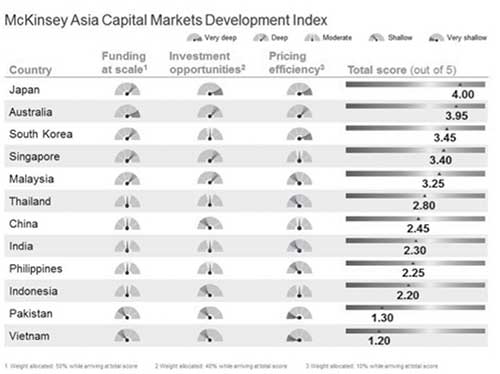Deepening capital markets in the Philippines
MANILA, Philippines - Across the Philippines and Asia’s other emerging economies, some $800 billion in investment opportunities go unfilled each year because capital markets are less reliable than issuers might like.
Infrastructure is a particularly acute need for the Philippines, which has set an ambitious goal of increasing its infrastructure spending to seven percent of GDP.
In addition, if the cost of capital in the Philippines were lower and more stable, businesses would have an easier time raising money to fund new ventures and growth projects that could turbo-boost the country’s development and add to the incomes and wealth of its people.
Although the situation is getting better, the Philippines has capital markets that are not yet as deep as those of several other Asian emerging economies (Exhibit 1). As our colleagues note in a recent report on the capital markets of emerging Asia, the Philippines has room to improve on several important indicators of capital market depth.
• Equities, private and public bonds, and securitized products amount to 130 percent of GDP. This is comparable to China (136 percent) and India (118), but below Malaysia (275) and Thailand (184).
• Issuances of private capital market products and government bonds each totaled four percent of GDP, on average, between 2013 and 2015—not much less than the five plus percent level in China, Malaysia, and Thailand, but well under the nine percent threshold associated with the capital markets of developed economies.
• The Philippines’ ratio of outstanding government and private debt to GDP is below the 1:1 level that is considered deep.
• Companies pay higher costs of capital in the Philippines—more than 14 percent for equity, and between two and three percent for debt—than in several other Asian emerging economies.
The market for equities in the Philippines, its largest asset class, has rewarded equity investors with high risk-adjusted returns. The country’s Sharpe ratio, which measures returns per unit of risk, was 1.4 from 2008 to 2015. Most other markets in Asia had Sharpe ratios below one during that period (higher ratios indicate greater returns for a certain amount of risk).
On the other hand, low liquidity, high trading costs, and problematic hedging mechanisms are significant issues to address in the equities market. Tapping into the equity markets could also be made easier. As it is, more than 40 documents are required to list shares on the main trading exchange.
On the debt side, the government bond market is deepening more quickly than the market for corporate bonds, although it lacks liquidity across much of the yield curve. Overall, more accurate and timely pricing information would help attract investors.

Policies and institutions to promote deeper capital markets
Policy makers in the Philippines recognize the country’s need for deeper capital markets, and the country’s Capital Market Development Plan Blueprint calls for a variety of measures to strengthen markets and build the capacity of regulators. Two complementary courses of action could augment this.
The first is creating basic economic and social policies that will provide a foundation for longer-term market growth. We see four areas that warrant particular focus:
1. Expanding the investor base would help to expand the supply of capital. This base would ideally become both deep and broad, encompassing the full range of investors: buy-and-hold investors such as insurance companies and pension funds; buy-and-trade investors such as mutual fund managers; active investors, such as hedge funds, who help provide liquidity and improve pricing, but also need to be regulated appropriately; and private-market investors, who can provide capital to fund early stage businesses as well as turnarounds. Pulling in more investors will likely require a combination of marketing and education efforts.
2. Increasing the participation of issuers in the capital markets would help increase demand for capital. Various policies can help in this regard, such as encouraging the development of fast-growing small companies, accelerating the release of public-private partnership (PPP) initiatives that require fund raising by larger companies, and providing incentives for more private investment in infrastructure. Privatizing or listing state-owned enterprises, or at least mandating the use of debt markets by these entities, would also bring more issuers into the Philippines’ capital markets.
3. Charting a path toward sustainable integration with global markets should make it easier for foreign players to invest in the Philippines and for local investors to place money abroad, thereby diversifying sources of capital and types of investments. This might include marketing the Philippines as a destination for investments in industries other than business-process outsourcing, opening the Philippines to flows of inbound and outbound capital and trade, and aligning regulations with international standards.
4. Developing a deep, liquid government bond market would provide the benchmark pricing information that can help the corporate bond market to expand. To do this, governments need to issue debt on an ongoing basis, even when they run budget surpluses. In many cases, they also need to adopt different practices for issuing and managing debt: following a predictable issuance calendar, reopening “on the run” benchmarks (the most recently-issued debt securities of a given maturity), and establishing primary-dealer programs that balance dealers’ duties and privileges.
The second course of action available to policy makers is developing a market architecture: the institutions, regulations, and backbone systems, such as technology networks, that capital markets need to function well. This architecture consists of five important elements.
1. Independent, accountable regulators are vital to market development. Policy makers will need to determine what to regulate, so as not to stifle innovation, and how different regulatory bodies work together.
2. Cornerstone institutions, such as stock exchanges and credit rating agencies, play important roles in setting standards and focusing development. Establishing a mortgage regulator, for instance, could release capital that is now locked up in housing and help create a large securitization market. Policy makers will need to decide what institutions to create, and who should own and govern them.
3. Transparent rules and regulations, with predictable enforcement, help to decrease costs and risks for market participants. Policy makers must strike a balance between supervision and regulation and establish enforcement mechanisms that do not exceed the legal system’s capabilities.
4. Taxation policies have a strong influence on the development of capital markets: they can support, hamper, or distort them. In some markets, policy makers have gone beyond tax-neutral policies and provided tax incentives that encourage the development of specific activities and asset classes.
5. Using advanced technology in key parts of the financial infrastructure could be the biggest factor in the development of high-quality capital markets. Policy makers need to decide whether to permit the accelerated use of technology for certain market functions, such as blockchain technology for clearing and settlements. With the right policies in place, private players could fund and deploy most of the technologies to power effective markets.
Indeed, a coordinated, sustained effort by policy makers would likely do much more to deepen the Philippines’ capital markets than a series of ad hoc initiatives. Our discussions with officials outside the Philippines suggest that effective policy implementation is perhaps the most important factor for deepening capital markets — and one that can present challenges. Policy makers can start by setting long-term goals, then make a few simple but significant changes to get things moving in the right direction. Setting up effective regulatory institutions and reaching out to other stakeholders, such as private and public companies at home and abroad, encourages participation in the new system. Finally, policy makers can invest in educating and developing the talent that companies will need as their capital-markets activities increase.
Efficient allocation of funds is a key enabler of economic growth and social progress. Deepening capital markets in the Philippines should increase the flow of money to companies and public projects that can benefit society. Policy makers can do much to help deepen capital markets. By establishing pro-market policies, along with supportive rules and institutions, they can enable investors to put more of their money to work in the Philippines.
(Nitin Jain is a senior knowledge expert with McKinsey Knowledge Center’s Guargaon office, Fumiaki Katsuki is a partner with McKinsey’s Tokyo office, and Kristine Romano is a partner with the Manila office).
- Latest
- Trending



























